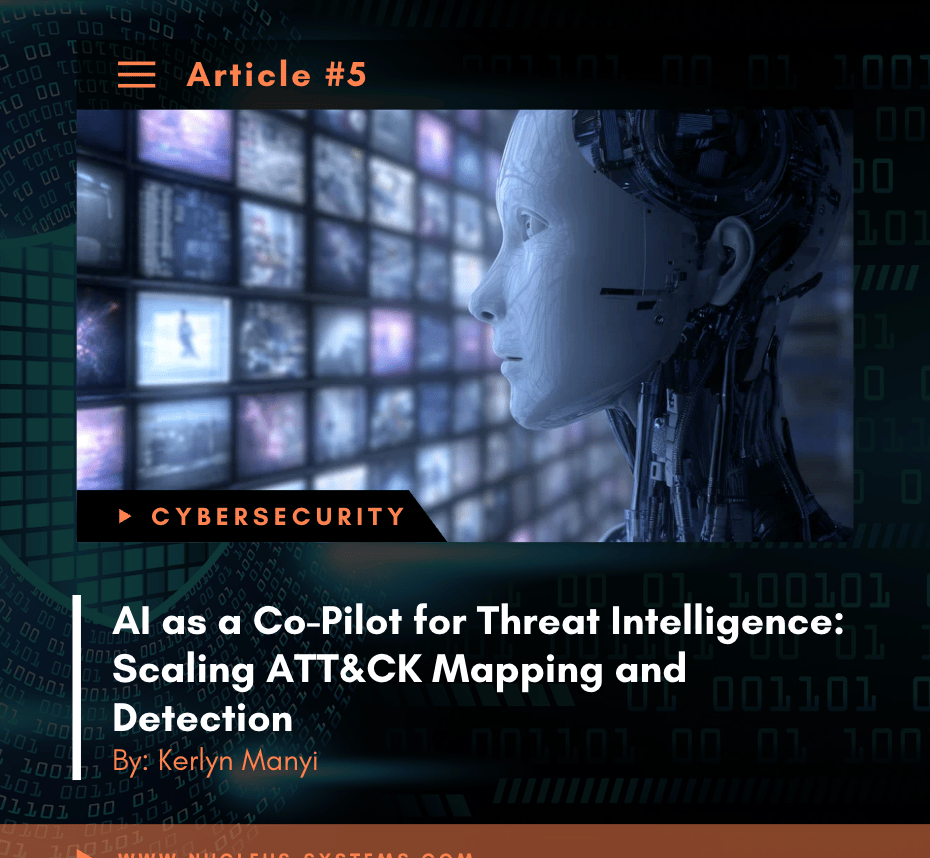
AI as a Co-Pilot for Threat Intelligence: Scaling ATT&CK Mapping and Detection
Threat adversaries are innovating faster than ever, and manual MITRE ATT&CK mapping is no longer scalable. This article dives into how AI acts as a "co-pilot," handling the grunt work of data ingestion and mapping, while keeping analysts firmly in control. We explore the power of behavioral analytics to spot subtle anomalies and how Generative AI allows teams to safely simulate "what-if" attack scenarios. Learn how to drastically increase your speed, consistency, and overall strategic impact.
Kerlyn Manyi
10/15/20254 min read


Cybersecurity is a race against adversaries who constantly evolve their tactics. Threat intelligence (CTI) teams are on the front line of this fight, studying incidents, malware campaigns, and threat reports to understand how attackers operate. Using frameworks like MITRE ATT&CK, which document the tactics, techniques, and procedures (TTPs) used in real-world intrusions, provides defenders and red teams with a shared framework to anticipate and counter attacks. But the attackers move fast. Thousands of new campaigns emerge every year, and relying on manual analysis or known indicators of compromise (IOCs) leaves gaps.
What organizations need is a way to move from reactive detection to proactive insight. This is where AI and behavioral analytics step in to amplify analysts' capabilities.
What Is MITRE ATT&CK and Why It Matters?
MITRE ATT&CK is a global knowledge base of how attackers behave once inside a system. Instead of listing IOCs like IPs or hashes, it maps how attacks unfold, from initial access to data exfiltration. For CTI teams, ATT&CK provides a shared language that helps defenders, red teams, and intelligence units collaborate effectively. Mapping threats to ATT&CK techniques reveals coverage gaps, sharpens detections, and enables more strategic defensive planning. As AI begins to automate parts of this mapping, analysts can shift from data labeling to higher-order reasoning, understanding adversary intent and likely next moves.
Beyond IOCs: Seeing the Bigger Picture
Traditional CTI reacts to known indicators. By the time an IP or hash appears on a blocklist, the attacker has usually moved on. AI-powered behavioral analytics changes that dynamic. It builds baselines of “normal” behavior across users, devices, and applications, and highlights subtle deviations such as:
Logins from unusual geographies or times.
Unexpected lateral movement across systems.
Processes executing outside their everyday context.
These signals help analysts detect early-stage intrusions and map them to ATT&CK before the compromise spreads.
Generative AI: Preparing for What’s Next
Generative AI brings predictive capability to threat intelligence. It can simulate attack chains that haven’t happened yet, helping analysts and detection engineers stay one step ahead.
Practical use cases include:
Testing ATT&CK coverage using synthetic but realistic attack data.
Generating new hypotheses for proactive hunts.
Exploring “what if” scenarios of adversary behaviors safely in sandboxed environments.
This shifts CTI from documenting what happened to anticipating what could happen next.
AI-Assisted ATT&CK Mapping: How It Works
Mapping reports and logs to ATT&CK techniques is essential but labor-intensive. AI can now accelerate this process while keeping analysts in control:
Ingest data from reports, logs, or alerts.
Extract relevant entities and IOCs via NLP.
Correlate behaviors using graph-based analytics.
Recommend ATT&CK mappings with confidence scores.
Summarise findings into concise, analyst-ready briefs.
The result: faster mapping, more consistent outputs, and more time for analysts to focus on strategy and response.
The Strategic Landscape: AI in the CTI Market
The global threat intelligence market, currently valued at around $12–14 billion, is expected to reach $25–30 billion by 2030, growing faster than the broader cybersecurity sector. The surge is driven by the demand for contextual, automated, and outcome-based intelligence, exactly where AI adds value.
Next-generation players like Filigran and Bfore.ai are reshaping the market:
Filigran, through OpenCTI, enables open, graph-based analysis that integrates seamlessly into SOC workflows, offering cost-effective flexibility.
Bfore.ai takes a predictive approach, using AI to forecast malicious infrastructure before it’s weaponized.
Meanwhile, incumbents such as Recorded Future and Anomali maintain scale and broad data coverage. The market is converging toward AI-augmented, workflow-native platforms, where integration depth, automation, and contextualization matter more than sheer data volume.
Future winners will be those who:
Offer modular, interoperable architectures (e.g., via STIX/TAXII and ATT&CK alignment).
Embed AI at the core for prioritization, narrative generation, and automated triage.
Deliver faster, more relevant intelligence that directly improves detection and response.
AI’s role here isn’t just technical; it’s strategic. It enables scalability, reduces analyst fatigue, and turns intelligence into a continuous operational advantage.
Open and Collaborative CTI: The Filigran Case Study
Modern CTI thrives on collaboration. Filigran’s OpenCTI project exemplifies the move toward open, AI-assisted platforms. By representing intelligence data as a graph of relationships, connecting threat actors, TTPs, and infrastructure, OpenCTI helps teams visualize and share insights. When enhanced by AI, this model enables:
Automatic enrichment of threat data.
Correlation across reports and campaigns.
Direct mapping of new observations to ATT&CK techniques.
It reflects a broader shift in the industry: from closed, feed-based intelligence to open, workflow-native, and AI-augmented ecosystems.
Limitations to Keep in Mind
AI brings promise, but not perfection.
False positives can arise from poor baselines.
Synthetic data may not always reflect real-world complexity.
Adversarial AI is a growing risk in itself.
Human oversight is indispensable; AI assists, it doesn’t replace.
AI should be treated as a co-pilot, not an autopilot.
Conclusion
The future of threat intelligence lies in human-AI collaboration. Behavioral analytics detects subtle anomalies early. Generative AI helps model what’s next. AI-assisted ATT&CK mapping accelerates workflows. An open CTI ecosystem like Filigran’s OpenCTI makes intelligence sharing more transparent and scalable.
As next-generation CTI players challenge incumbents, success will depend on how well AI is integrated into analyst workflows, not just as an add-on, but as a trusted partner in reasoning, prediction, and automation.
Attackers innovate relentlessly. Defenders must innovate faster. With AI as a co-pilot, CTI teams can scale expertise, reduce fatigue, and stay ahead of the curve.
